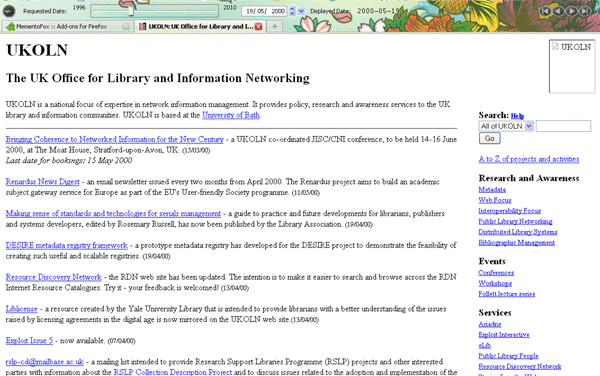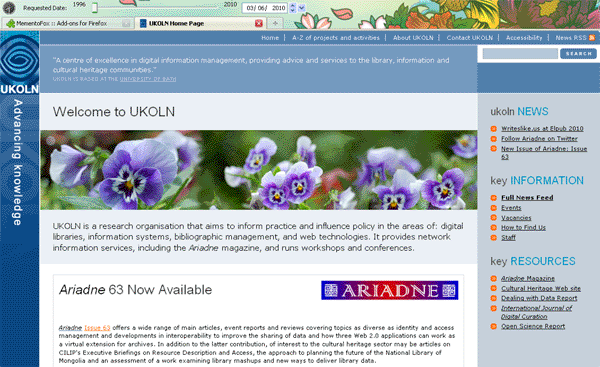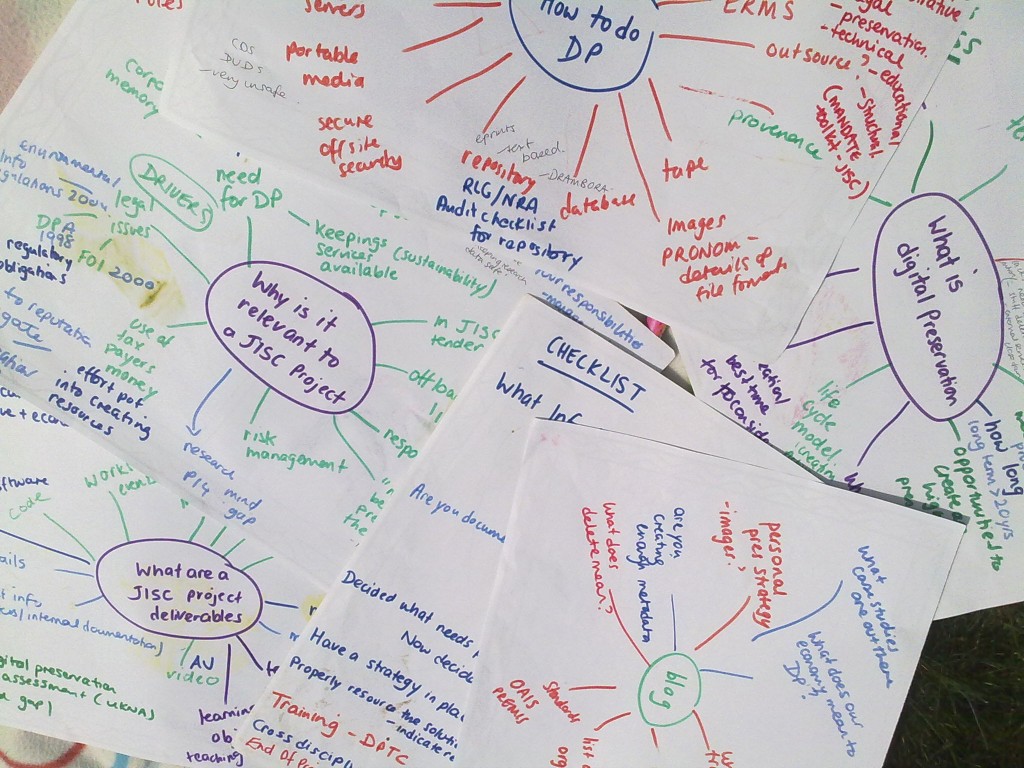Posted by Marieke Guy on 5th July 2010
A discussion between the Digital Preservation Coalition and the Digital Curation Centre has led to a new UKOLN Cultural Heritage briefing paper on ‘What To Do When a Service Provider Closes‘.
The original notes for the briefing paper (written by William Kilbride of the DPC) were offered in response to a cry for help from someone working for a non-for-profit organisation that is closing down due to the recession. They were looking for some guidance on what to do with their digital collections.
The briefing paper offers seven point checklist presents some steps that creators and managers of community digital archives might take to make sure that their data is available in the long term.
The key suggestions are:
- Keep the Masters
- Know What’s What
- There Should be a Disaster Plan
- Agree a Succession Plan
- Know Your Rights
- Find a Digital Preservation Service
- Put a Copy of your Web Site in a Web Archive
William commented on the guidance:
“This will be a growing area of business – and it’s illustrative of the gap between the advice that people need and the advice that’s out there.
Hopefully the Beginner’s Guide to Digital Preservation will be able to put more people in touch with information that helps them sort out their very immediate digital preservation problems.
The guide is available in Word and as a Web page.
There are now 82 Cultural Heritage briefing papers available on the UKOLN Cultural Heritage Web site. The papers are concise and clear and make excellent training materials. There are several related to digital preservation:
- An Introduction to Digital Preservation, (briefing 31): [About] – [MS Word]
- Mothballing Your Web Site, (briefing 32):[About] – [MS Word]
- Top Ten Tips For Web Site Preservation, (briefing 33): [About] – [MS Word]
- Preservation and Sustainability, (briefing 40): [About] – [MS Word]
- Developing Your Digital Preservation Policy, (briefing 42): [About] – [MS Word]
- Introduction to Web Resource Preservation, (briefing 49): [About] – [MS Word]
- Preserving Web 2.0 Resources, (briefing 50): [About] – [MS Word]
- Preserving Your Home Page, (briefing 51): [About] – [MS Word]
- Selection for Web Resource Preservation, (briefing 52): [About] – [MS Word]
- Web Archiving, (briefing 53): [About] – [MS Word]
- What To Do When a Service Provider Closes, (briefing 82): [About] – [MS Word]
Posted in Project news | 1 Comment »
Posted by Marieke Guy on 10th June 2010
If you are involved in a JISC project (or work in a similar environment) and would like to offer us a case study of your digital preservation methods please do get in touch.
Some areas that you might want to include in your case study are:
- The background to your project.
- A description of the digital preservation problem being addressed.
-
An explanation of the approach taken.
-
A summary of any problems experienced.
-
An explanation the things you would do differently today, based on the experienced you have gained.
-
References
-
Contact Details
Posted in Project news | 1 Comment »
Posted by Marieke Guy on 8th June 2010
Yesterday David Cameron warned the British public of what he called the “inevitably painful times that lie ahead“. His speach referred to the spending cuts that are seen to be necessary to reduce the 70 billion debt the UK currently has. A few weeks ago the Coalition government unveiled their first round of spending cuts and the budget on 22 June is likely to lower the axe again. The Department for Business Innovation & Skills (BIS) has the Higher Education budget down for £200 million in efficiencies.
It is inevitable that a number of organisations will close and many projects will come to an end. British Educational Communications and Technology Agency (Becta), the organisation which promotes the use of technology in schools was one of the first to go.
So what role will digital preservation and access play in the current economic and fiscal situation?
Digital preservation is more important than ever in a time when the wealth of what JISC and other government funded organisations have created could potentially slip away.
After the closure of Becta was announced there was much discussion on Twitter about what would happen to their Web site and their intellectual assets. Some of their work will be carried by other government organisations and it’s likely that these resources will be transfered over to other sites and databases. Their Web site is currently one of those preserved by the National Archives however there are still questions over what else will be preserved and the processes that will take place. Will they mothball their Web site? What other Web resources will they save? They would do well to consult the JISC Preservation of Web Resources handbook.
It will be an interesting case study to watch.
Howerver it is not only government digital objects that are at risk. Those of commercial companies are unlikely to stand the test of time either.
In response to this the UK Web Archive have created a collection for the recession containing Web sites from high street stores closed down.The Credit Crunch Collection initiated in July 2008 contains records of high-street victims of the recession including Woolworths and Zavvi.
There is also a worry that many digital records from bankrupt companies will dissapear in the haste to sell off assets. On his blog a records manager explains how in the past archivists have waded in to save companies records in a form of “rescue” archiving. However “When a modern business goes bust, many of its records will exist only in electronic form….The inheriting organisation will always be under pressure to take the easiest and cheapest way to dispose of a predecessor’s assets, which in practice probably means that data will be wiped and the hardware sold on. “.
It seems that much is likely to be lost in the next few years in we aren’t careful.
Posted in Project news, Web | Comments Off
Posted by Marieke Guy on 3rd June 2010
I’ve been having a little play with MementoFox, a firefox addin that “links resources with their previous versions automatically, so can you see the web as it was in the past“.
Once you have installed the addin a little slider bar is added to your Firefox Web browser. When browsing any Web site you can use the slider bar to select a date on which you’d like to see the shown page. Momento will then look for the closest archived copy available. As you can see I have used MementoFox on the UKOLN home page.
Below is the page for around the time I started working at UKOLN – 10 years ago! The page here is taken from the Internet Archive Wayback machine.

UKOLN Home page in 2000
And here is the page as it is now.

UKOLN Home page in 2010
I initially used version 0.8.6 of MementoFox and had a few problems with viewing embeds (of video, slides etc.) of blogs in Firefox. Version 0.8.7 seems to have sorted this out.
The Memento Project Web site is definitely worth taking a look at. There are various time traveling scenarios and walkthroughs and more information on where the project is going. The project “wants to make it as straightforward to access the Web of the past as it is to access the current Web.”

Memento slider bar
At this point, there aren’t any formal technical specifications detailing the Memento framework but we will get to that. For now, the information on this site should provide quite a good insight into how Memento is trying to change the Web by adding a time dimension to its most common protocol, HTTP…If you are interested in establishing a Web with a memory, please join the Memento Development Group.
Maybe in the future we’ll be able to switch our ‘time-versions’ of Web pages as easily as we switch our blog themes.
Posted in Project news | Comments Off
Posted by Marieke Guy on 24th May 2010
Last week I took some time out to brainstorm on a structure for the JISC Beginner’s Guide to Digital Preservation. The nice weather meant I could sit out in the garden and use my felt tips to create some useful mind maps. I now have a working structure which I hope to confirm this week after I’ve run it by a colleague.

The relatively short time-scale and limited people resources for this project have meant that the engagement I can have with my audience is limited. I have had to be selective about what I do and am relying heavily on data that is already out there rather than trying to gather my own. I probably won’t be able to run a survey of project workers in order to establish where their digital preservation needs lie – though there is a lot of information already available in this area (for example the Digital Preservation Coalition Mind the Gap survey was very useful, no need to read it all, this Ariadne article offers a useful summary). However I do intend to engage JISC project staff slightly further down the line and will be asking for feedback on the areas I propose covering.
Of course people are always welcome to comment on this blog.
Posted in Project news | 1 Comment »
Posted by Marieke Guy on 29th April 2010
 I’m Marieke Guy and I am project manager for the JISC Beginner’s Guide to Digital Preservation project. I am have been interested in digital preservation for some time and previously worked on the Preservation of Web Resources project (JISC-PoWR).
I’m Marieke Guy and I am project manager for the JISC Beginner’s Guide to Digital Preservation project. I am have been interested in digital preservation for some time and previously worked on the Preservation of Web Resources project (JISC-PoWR).
I am a Research Officer at UKOLN, a centre of excellence in digital information management, providing advice and services to the library, information and cultural heritage communities. I am chair of the Institutional Web Management Workshop, a 3-day annual event for those involved in the provision of institutional Web services. Much of my work involves exploring Web 2.0 technologies and their relevance to the communities we work with. I am remote worker champion for UKOLN and write a blog about my remote working experiences.
More information about me is available from my staff page.
Posted in Project news | Comments Off
Posted by Marieke Guy on 27th April 2010
Back in 2009 it was agreed that UKOLN would work on a document which seeks to provide digital preservation information for members of the JISC community who aren’t active in this area. This document will take a straightforward approach to the subject area, be pragmatic and be applicable to those who are new to the topic area. It is intended that the final document will prove to be a core resource for the JISC community.
This project, looking at what the JISC Beginner’s Guide to Digital Preservation will constitute, began at the start of April runs to the end of September 2010. Note that while it is referred to as a document here what exactly it will be is still undecided.
This blog will record the progress of the project. It will be a record of (to quote a colleague) “adventures and discoveries in Digital Preservation land“. It will be the central location for the information and links collected and the connexions made.
Welcome to the JISC Beginner’s Guide to Digital Preservation blog!
Posted in Project news | 1 Comment »




